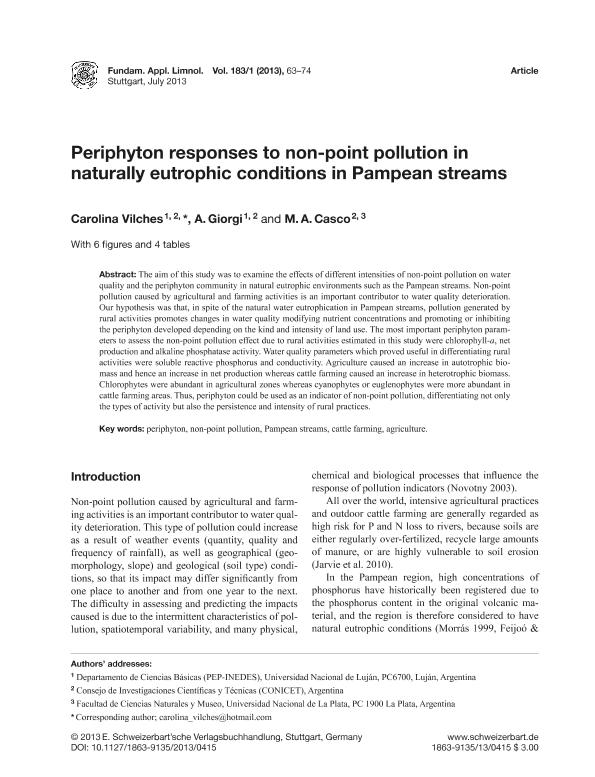Artículo
Periphyton responses to non-point pollution in a natural eutrophic condition in Pampean streams
Fecha de publicación:
07/2013
Editorial:
E Schweizerbartsche Verlags
Revista:
Fundamental And Applied Limnology
ISSN:
1863-9135
Idioma:
Inglés
Tipo de recurso:
Artículo publicado
Clasificación temática:
Resumen
The aim of this study was to examine the effects of different intensities of non-point pollution on water quality and the periphyton community in natural eutrophic environments such as the Pampean streams. Non-point pollution caused by agricultural and farming activities is an important contributor to water quality deterioration. Our hypothesis was that, in spite of the natural water eutrophication in Pampean streams, pollution generated by rural activities promotes changes in water quality modifying nutrient concentrations and promoting or inhibiting the periphyton developed depending on the kind and intensity of land use. The most important periphyton parameters to assess the non-point pollution effect due to rural activities estimated in this study were chlorophyll-a, net production and alkaline phosphatase activity. Water quality parameters which proved useful in differentiating rural activities were soluble reactive phosphorus and conductivity. Agriculture caused an increase in autotrophic biomass and hence an increase in net production whereas cattle farming caused an increase in heterotrophic biomass. Chlorophytes were abundant in agricultural zones whereas cyanophytes or euglenophytes were more abundant in cattle farming areas. Thus, periphyton could be used as an indicator of non-point pollution, differentiating not only the types of activity but also the persistence and intensity of rural practices.
Palabras clave:
Periphyton
,
Non-Point Pollution
,
Pampean Stream
,
Cattle Farming
,
Agriculture
Archivos asociados
Licencia
Identificadores
Colecciones
Articulos(CCT - LA PLATA)
Articulos de CTRO.CIENTIFICO TECNOL.CONICET - LA PLATA
Articulos de CTRO.CIENTIFICO TECNOL.CONICET - LA PLATA
Articulos(SEDE CENTRAL)
Articulos de SEDE CENTRAL
Articulos de SEDE CENTRAL
Citación
Vilches, Carolina; Giorgi, Adonis David Nazareno; Casco, Maria Adela; Periphyton responses to non-point pollution in a natural eutrophic condition in Pampean streams; E Schweizerbartsche Verlags; Fundamental And Applied Limnology; 183; 1; 7-2013; 63-74
Compartir
Altmétricas




